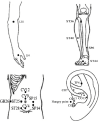Mechanism of Action of Acupuncture in Obesity: A Perspective From the Hypothalamus
- PMID: 33868169
- PMCID: PMC8050351
- DOI: 10.3389/fendo.2021.632324
Mechanism of Action of Acupuncture in Obesity: A Perspective From the Hypothalamus
Abstract
Obesity is a prevalent metabolic disease caused by an imbalance in food intake and energy expenditure. Although acupuncture is widely used in the treatment of obesity in a clinical setting, its mechanism has not been adequately elucidated. As the key pivot of appetite signals, the hypothalamus receives afferent and efferent signals from the brainstem and peripheral tissue, leading to the formation of a complex appetite regulation circuit, thereby effectively regulating food intake and energy homeostasis. This review mainly discusses the relationship between the hypothalamic nuclei, related neuropeptides, brainstem, peripheral signals, and obesity, as well as mechanisms of acupuncture on obesity from the perspective of the hypothalamus, exploring the current evidence and therapeutic targets for mechanism of action of acupuncture in obesity.
Keywords: action; acupuncture; hypothalamus; mechanism; obesity.
Copyright © 2021 Wang, Yu, Li, Tian and Du.
Conflict of interest statement
The authors declare that the research was conducted in the absence of any commercial or financial relationships that could be construed as a potential conflict of interest.
Figures




Similar articles
-
Hypothalamic lipids and the regulation of energy homeostasis.Obes Facts. 2009;2(2):126-35. doi: 10.1159/000209251. Epub 2009 Apr 3. Obes Facts. 2009. PMID: 20054216 Free PMC article. Review.
-
Hypothalamic inflammation and obesity: a mechanistic review.Arch Pharm Res. 2019 May;42(5):383-392. doi: 10.1007/s12272-019-01138-9. Epub 2019 Mar 5. Arch Pharm Res. 2019. PMID: 30835074 Review.
-
The role of neuronal AMPK as a mediator of nutritional regulation of food intake and energy homeostasis.Metabolism. 2013 Feb;62(2):171-8. doi: 10.1016/j.metabol.2012.07.001. Epub 2012 Aug 14. Metabolism. 2013. PMID: 22898253 Review.
-
The role of pancreatic polypeptide in the regulation of energy homeostasis.Mol Cell Endocrinol. 2015 Dec 15;418 Pt 1:33-41. doi: 10.1016/j.mce.2015.06.028. Epub 2015 Jun 27. Mol Cell Endocrinol. 2015. PMID: 26123585 Review.
-
Metabolic vs. hedonic obesity: a conceptual distinction and its clinical implications.Obes Rev. 2015 Mar;16(3):234-47. doi: 10.1111/obr.12246. Epub 2015 Jan 14. Obes Rev. 2015. PMID: 25588316 Free PMC article. Review.
Cited by
-
Electroacupuncture induces weight loss by regulating tuberous sclerosis complex 1-mammalian target of rapamycin methylation and hypothalamic autophagy in high-fat diet-induced obese rats.Front Pharmacol. 2022 Oct 12;13:1015784. doi: 10.3389/fphar.2022.1015784. eCollection 2022. Front Pharmacol. 2022. PMID: 36313328 Free PMC article.
-
The Connectome and Chemo-Connectome Databases for Mice Brain Connection Analysis.Front Neuroanat. 2022 Jun 9;16:886925. doi: 10.3389/fnana.2022.886925. eCollection 2022. Front Neuroanat. 2022. PMID: 35756500 Free PMC article.
-
Perspectives in clinical research on acupuncture treatment for central obesity: A perspective.Medicine (Baltimore). 2025 May 23;104(21):e42634. doi: 10.1097/MD.0000000000042634. Medicine (Baltimore). 2025. PMID: 40419875 Free PMC article. Review.
-
The Effect of Auriculotherapy on an Overweight Pregnant Women's Weight-Gaining Pattern: A Randomized Controlled Clinical Trial.Evid Based Complement Alternat Med. 2023 Sep 28;2023:7192142. doi: 10.1155/2023/7192142. eCollection 2023. Evid Based Complement Alternat Med. 2023. PMID: 37808138 Free PMC article.
-
Electroacupuncture modulates the gut-brain axis via the PI3K/Akt pathway to improve feeding behavior, body weight, glucolipid metabolism, and reduce insulin resistance in T2DM rats.Diabetol Metab Syndr. 2025 Apr 9;17(1):122. doi: 10.1186/s13098-025-01683-y. Diabetol Metab Syndr. 2025. PMID: 40205499 Free PMC article.
References
-
- Ezzati M, Bentham J, Di Cesare M, Bilano V, Bixby H, Zhou B, et al. . Worldwide trends in body-mass index, underweight, overweight, and obesity from 1975 to 2016: a pooled analysis of 2416 population-based measurement studies in 128·9 million children, adolescents, and adults. Lancet (London England) (2017) 390(10113):2627–42. 10.1016/s0140-6736(17)32129-3 - DOI - PMC - PubMed
Publication types
MeSH terms
LinkOut - more resources
Full Text Sources
Other Literature Sources
Medical
Research Materials

